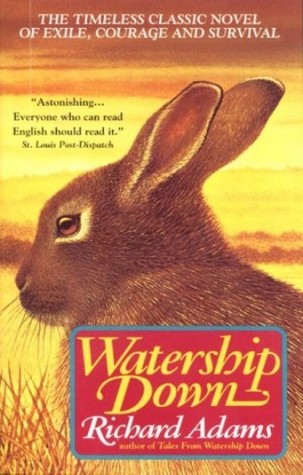 Watership Down is one of those children's books that I never read. It's not that I disliked books about animals--in fact, I loved the Redwall books when I was younger, and the Narnia books have a good number of talking animals as well. But for some reason, I thought this was a book about rabbits going to war. And like in rabbit-y ways--like, basically World War II with rabbits. I'm not entirely sure where I got this idea, but I think it might have been the title; it just sounds like some sort of distress call from a boat that's been struck by a torpedo: "SOS! Watership down, I repeat, Watership down! SOS!"
Watership Down is one of those children's books that I never read. It's not that I disliked books about animals--in fact, I loved the Redwall books when I was younger, and the Narnia books have a good number of talking animals as well. But for some reason, I thought this was a book about rabbits going to war. And like in rabbit-y ways--like, basically World War II with rabbits. I'm not entirely sure where I got this idea, but I think it might have been the title; it just sounds like some sort of distress call from a boat that's been struck by a torpedo: "SOS! Watership down, I repeat, Watership down! SOS!"I finally got around to reading it because it was the Deliberate Reader book club selection for April in the Facebook group. It also slotted nicely into my reading challenge category for a book that is a parable; while Adams did not intend the book to be a parable, saying that it was just a book about rabbits, it seems it's frequently read as a parable, and that's good enough for me.
The plot here is fairly basic. Adams builds a society of rabbits, but keeps them in their natural habits and forms; they talk and act and think, but they're not necessarily anthropomorphized in the way that, say, Mickey Mouse is. Within this society, some rabbits are gifted with seeing; in the warren of rabbits that starts the book, one of these seers if Fiver, the best friend of the main rabbit, Hazel. Fiver predicts some unknown devastation for the warren, and on his warning, Hazel convinces some other rabbits to leave the warren with them. They strike out into the countryside, seeking a place to build a new warren. Along the way they encounter other rabbits who fled their warren, and encounter other rabbits not of their group. And even when they establish a new home, they can't live in contentment, because without any females, they can't sustain a new colony. And it's this struggle for survival, both immediately and in the long term, that drives the book.
Throughout the story, Hazel grows from an undersized, un-listened-to rabbit to the leader of the group, using logic instead of emotion and pushing on in the face of fear in order to take the new warren to safety. We also get to see several different modes of warren society; the home warren, the one they encounter on the way, the one they establish on Watership Down, and Efrafa. We also encounter other colorful characters, such as General Woundwort and the best character in the entire book, the bird Kehaar. Human society is glimpsed through the rabbits' eyes and the story is bulked up by tales of the mythical rabbit who was the original rabbit leader, in the style of Br'er Rabbit and other trickster stories.
The writing was surprisingly engaging. While it got off to a slow start, I soon found myself wrapped up in the story. I didn't expect to enjoy it nearly as much as I did, but the different types of rabbit societies offered a wonderful study of contrasts, and seeing our core group of rabbits come together and learn to triumph as a cohesive group rather than a bunch of misfits was a great central propulsion. Hazel was also definitely the proper choice for a central character. The other two obvious choices would be Bigwig or Fiver, either of whom would have quickly become annoying as a main character--Bigwig because of his impulsivity, and Fiver because of his Timidity. The other types of animals also held enough difference and interest to not make the book bland, which it could have easily become.
Overall, I was pleasantly surprised by my reading experience. This is another one I can cross of my classics list, and I even recommended it to a few people who'd had similar misconceptions about the book. A worthy read.
4 stars out of 5.
No comments:
Post a Comment